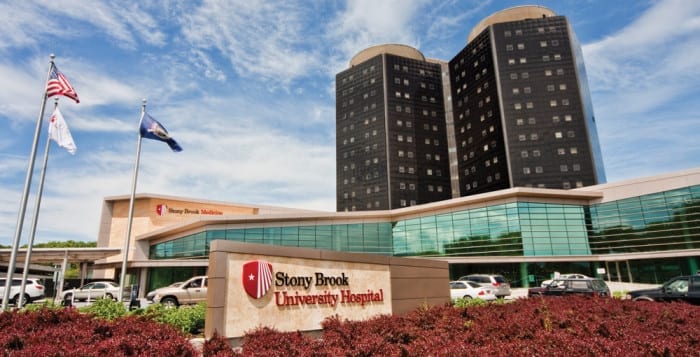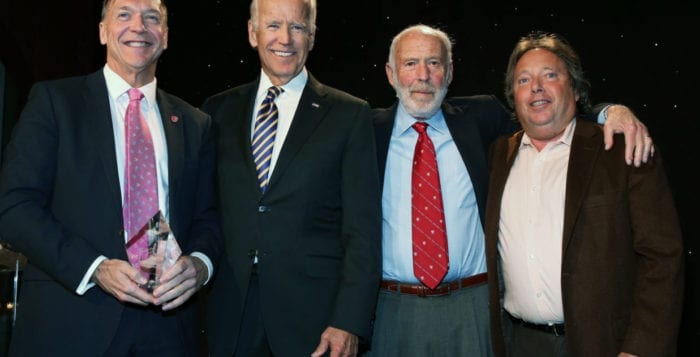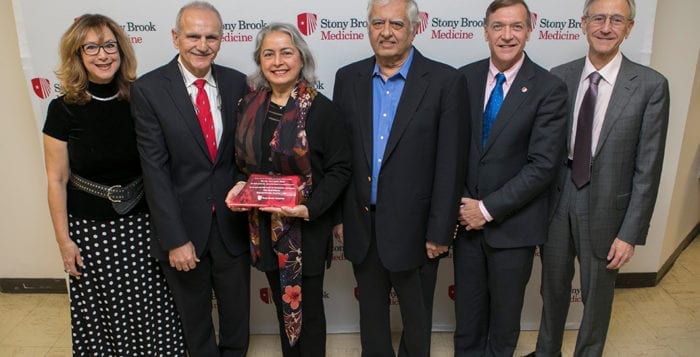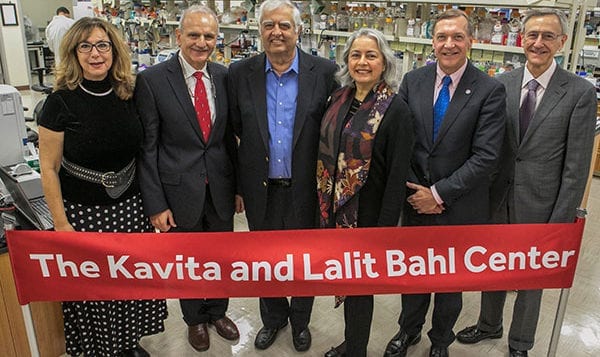By Daniel Dunaief
Many ways to kill cancer involve tapping into a cell’s own termination system. With several cancers, however, the treatment only works until it becomes resistant to the therapy, bringing back a life-threatening disease.
Collaborating with researchers at several other institutions, Dr. Lina Obeid, the director of research at Stony Brook University School of Medicine, has uncovered a way that cancer hides a cell-destroying lipid called ceramide from treatments. The ceramide “gets co-opted by fatty acids for a different species of fats, namely acylceramide, and gets stored side by side with the usual triglycerides,” Obeid explained in an email about her recent finding, which was published in the journal Cell Metabolism. “It makes the ceramide inaccessible and hence the novelty.” The ceramide gets stored as a lipid drop in the cell.
“We describe a completely new metabolic pathway and role in cell biology,” Obeid said. Other researchers suggested that this finding could be important in the battle against cancer. “That acylceramides are formed and deposited in lipid droplets is an amazing finding,” George Carman, the director of the Rutgers Center for Lipid Research, explained in an email. “By modifying the ceramide molecule with an acyl group for its deposit in a lipid droplet takes ceramide out of action and, thus, ineffective as an agent to cause death of cancer cells.”
Carman said Obeid, whom he has known for several years, visited his campus in New Jersey to share her results. “All of us at Rutgers were so excited to hear her story because we knew how important this discovery is to the field of lipid droplet biology as well as to cancer biology,” he said. Obeid conducted some of the work at the Kavita and Lalit Bahl Center for Metabolomics and Imaging at Stony Brook University. The center officially opened on Dec. 1 of last year on the 15th floor of the Health Sciences Center and will move to the Medical and Research Translation Building when it is completed next year. “This study is exactly the kind of major questions we are addressing in the center that [the Bahls] have generously made possible,” she explained.
Obeid discovered three proteins that are involved in this metabolic pathway: a ceramide synthesizing protein called CerS, a fatty acyl-CoA synthetase protein called ACSL and an enzyme that puts them together, called DGAT2, which is also used in fatty triglyceride synthesis. Her research team, which includes scientists from Columbia University, Northrop Veterans Affairs Medical Center and Mansoura University in Egypt is looking into implications for the role of this novel pathway as a target for cancer and obesity.
Indeed, obesity enables more frequent conversion of ceramide into acylceramide. “Fats in cells and in diets increase and predispose to obesity,” Obeid suggested. “This new pathway we found occurs when fatty acids are fed to cells or as high-fat diets are fed to mice.” In theory, this could explain why obesity may predispose people to cancer or make cancer resistance more prevalent for some people. According to Obeid, a high-fat diet can cause this collection of proteins to form in the liver of mice, and she would like to explore the same pathways in humans. Before she can begin any such studies, however, she would need numerous approvals from institutional review boards, among others.
Obeid and her collaborators hypothesize that a lower-fat diet could reduce the likelihood that this lipid would be able to evade cancer therapies.
These kinds of studies “provide the justification for looking at the effect of diet on acylceramide production,” Daniel Raben, a professor of biological chemistry at Johns Hopkins University School of Medicine, explained in an email. Further research could include “isocaloric studies with [high-fat diets] and [low-fat diets] in animals that are age and gender matched.”
Obeid was a part of the first group to describe the lipid’s role in cancer cell death in 1993. “We have been studying its metabolism and looking at how it’s made and broken down,” she said. “We found recently that it associates with these proteins to metabolize it.”
While the lipid provides a way to tackle cancer’s resistance to chemotherapy, it also has other functions in cells, including as a membrane permeability barrier and in skin. A therapy that reduced acylceramide could affect these other areas but “as with hair loss [with chemotherapy treatment], this will likely be easily managed and reversible,” Raben explained.
Obeid and Yusuf Hannun, the director of the Cancer Center at Stony Brook, are searching for other scientists to work at the Kavita and Lalit Bahl Center for Metabolomics and Imaging. “We are actively recruiting for star scientists” at the center, Obeid said. Other researchers suggested that the history of the work Obeid and Hannun have done will attract other researchers.
Hannun and Obeid are “considered the absolute leaders in the area of sphingolipid biochemistry and their clinical implications,” Raben said. “Simply put, they are at the top of this academic pile. Not only are they terrific scientists, they also have an outstanding and well-recognized reputation for training and nurturing young investigators.” Carman asked, “Who wouldn’t want to be associated with a group that continues to make seminal contributions to cancer biology and make an impact on the lives of so many?”
As for the next steps in this particular effort, Carman foresaw some ways to extend this work into the clinical arena. “I can imagine the discovery of a drug that might be used to combat cancer growth,” Carman said. “I can imagine the discovery of a drug that might control the acylation of ceramide to make ceramide more available as a cancer cell inhibitor. Clearly, [Obeid’s] group, along with the outstanding colleagues and facilities at Stony Brook, are positioned to make such discoveries.”










